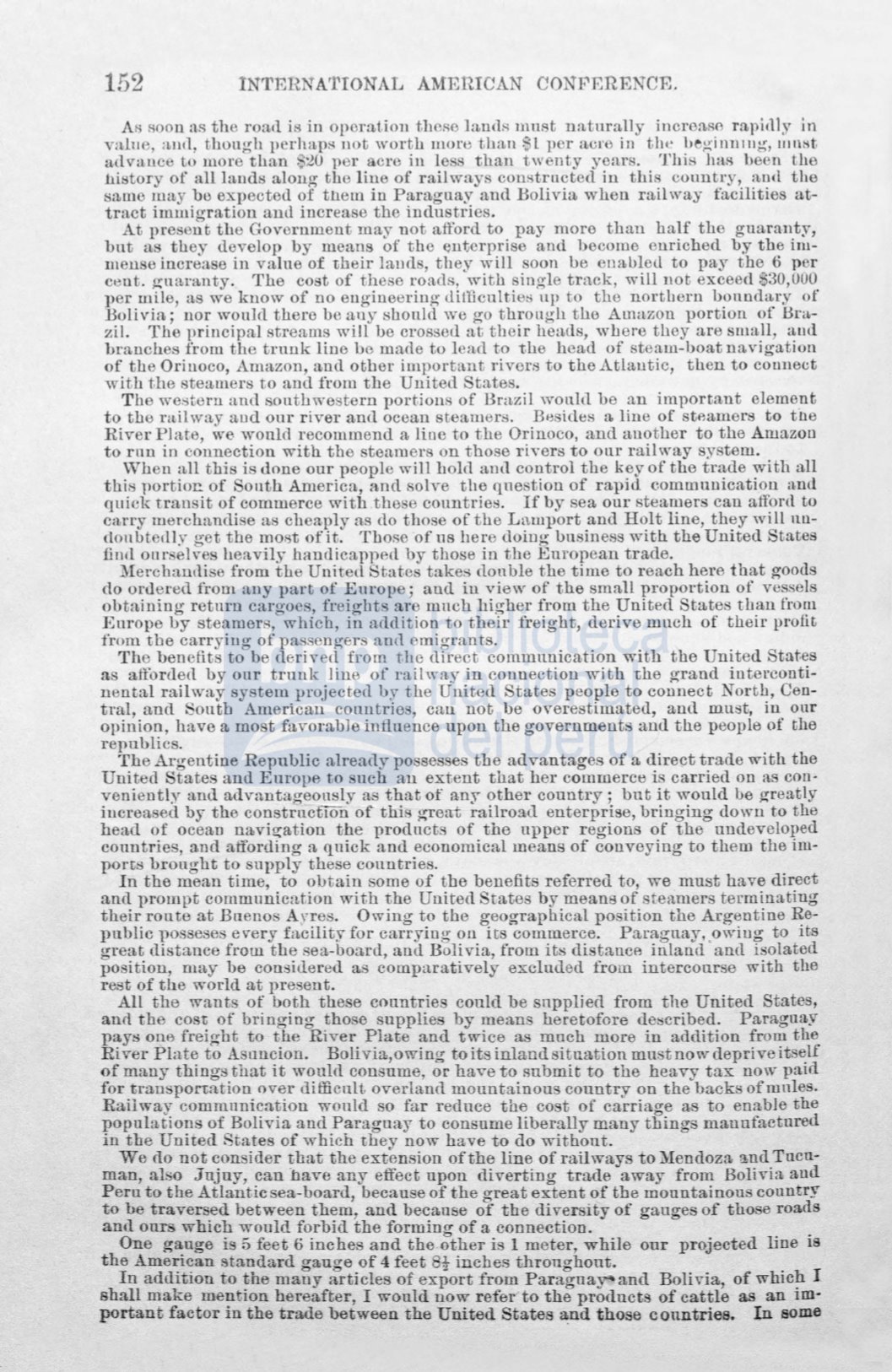

152
lNTERNATIONAL AMERICAN CONFERENCE.
A H
fiOOn as the roall is in opcra.tion thcRe lancls mn11t natnrally iucrcasc rapidly in
val11e, anll, though perhapr-; not worth more than
$L
por acl'e in the beginu1ng, 111nst
ad vanee to ruore tlum
~~o
p r acre in le s t han twenty years. This has been tlle
.b.i tory of alllands along the line of railways constrncted in thi country, anü the
samc may be expected of tuero in Paraguay and Bolivia when r:1ilway facilities at–
tract immigration aml increase the industries.
At present the Govcrnment may not afford to pay more than half the guaranty,
bnt as they develop by means of t he enterprise and become enriched by the im–
mense increase in value of liheir lauds, they will soon be enabled to pa.)-r the 6 per
cent. gnaranty. The cost of these roads, with singl e track, will not exceed $30,000
per mile, as we know of no eugineering d itficultie.
11p
to the nortbern boundar.v of
Bolivia; nor would there be auy shonld we go throngh the Amazon portion of Bra–
zil. The principal treams will be crosseJ at tbei r heaJs, wbere they are sruall aml
branches from tbe trnnk line be made to lead to the head of steam-boat navigation
of the Oriuoco, Amazon, and other important rivcrs to the Atlautic, then to couuect
wit h the steamers to and from the United States.
The
western and outhwe tern port.ions of Bmzil woultl be an important element
to the
ra.il way and our river and ocean steamers.
B11
ides a line of stP-amers to tue
River
Pla.te,we wonld r ecommend a line to the Orinoco, and a.uother to the Amazon
to ran in connectiou with the
teamers on t hose ri\ers to our railway system.
When all tbis is done our people will holcl am1 control the key of the trade with all
this portio!! of Sonth America, and solve the qne tion of rapid commnuication and
quick transit of commerce witb tbese conntries.
If
by sea our stearners can afford to
carry merchanclise as cheaply as do tho e of the L amport and Holt line, they will nn–
doub tedly get tbe most ofit. Tbose of us bere doing bnsiness with the United States
firul
ourselves beavüy handicapped by those in thc Buropean tracle.
Mercbandi e from the Uniteü S tates takes double the time to reach here that goods
do ordered from any part of Europe; and in view of the small proportion of ves:els
obtaining retnrn cargocs, freight m·e rnnch higher from the United State tban from
Enrope by steamers, which, in acldition to their freight, derive much of their profit
from tbe carryiug of passengers and emigrants.
Thc benefits to be d erived from tlte direct communication with tbe United States
as afforded by our trunk line of railway in connection with -¡;he granel interconti–
nental railway ystem l_Jrojected by the United State people to connect Nortb, Cen–
tral, and Sonth American conntrie , cau not be overestimated, and must, in our
opinion, have amo t favorable infl.uence upou the governments and the people of the
repnblics.
The Argentine Repnblic already po sesses the advantages of a direct trade with the
Uni.ted 'tates and Europe to uch au extent that her commerce i carried on as con–
ven iently and advantageously a· that of any other country; but it would ue greatly
iucreased
by
the construc ron of thi grerrt railroad enterprise, bringing clown to the
head of ocean navigation the product of the upper regions of the undeveloped
conntries, and affording a qnick and economical means of couveying to them the im–
ports bronght to supply these countries.
In tbe mean time, to outain sorne of tbe benefits referred to, we must bave direct
and prompt commuuicat.iou with the United States by means of teamer terminatiug
their route at Buenos Ayre ·.
Owing
to the geographical po ition the Argentina Re–
public posseses every facility for carrying ou its commerce. Paraguay, ,owiug to
its
"reat distance from thc ea-board, and. Bolivia, from its distance inland and isolated
position, may be cousiJered as comparatively excluded from intercourse with tbe
re t of the world at pre ent.
All the want · of both these conntrie could be snpplied from the United States,
and tbe cosli of bringing those supplie by mean heretofore de ·cribed. Paraguay
pay:; one freigbt to the Ri ver Plate and twice as moch more in addition froru the
River Plate to Asuncion. Bolivia,owing toitsinlandsituation mustnowdeprive itself
of many thing that it would consume, or bave to Hnbmit to the heavy tax now paid
for transportation over Jifficult, overland mountainous conntry on the back ofmnle .
Railway commnnication would so far reduce the co t of carriage a
to enable the
popula.tions of Bolivia aud Pamguay to consume liberaUy many things manufactured
in tbe Unitecl. tates of which they now have todo without.
We do not consider that the extension ofthe line of raílways to
~1endoza
and Tucu–
man, also Jnjuy, can havc any effect upon diverting trade away from Bolivia and
Peru to tbe Atlantic ea-board, becan eoftbe great extent of the mountainou conntry
to be traver ed between them, and becanse of the diversity of gauges of tho e roa.ds
anu ours which would forbid the forming of a connection.
_One gauge i 5 feet 6 inches and the other
is
1 meter, while our projected line
IS
tbe American standard O'aUO'e of 4 feet
~
inches throuO'hout.
In addition to the many articles of export frorn Paraguay-and Bolivia, of which I
sball make mention hereafter, I would now refer to the product of cattle as an im–
portant factor in the trade between the United State
~nd
those countries.
In
some
















